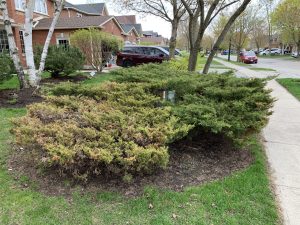
Would like you advice if the less green section of this bush can be saved or not. If so how and if not do I just remove that portion?
Thank you for contacting Toronto Master Gardeners. Conifers, especially the kind like yours that can be kept relatively small are sometimes known as “dwarf” varieties. The name can be misleading since they can still grow quite large. Conifers are an indispensable way to beautify a garden and give it structure.
While a close-up photograph would be ideal, what you have may be a kind of juniper, a large group of conifers that are available in many shapes, sizes, and growth habits. The American Conifer Society (https://conifersociety.org) lists about 50 species of juniper! It could also be a kind of false cypress, or Chamaecyparis. While often depended upon to serve as the backbone to an easy-to-maintain garden, these conifers are not invulnerable to decay if their preferred growing conditions are compromised. Problems can be due to many factors including lack of water or nutrients, poor drainage, and occasionally pests and diseases caused by things like fungi. The most common cause of browning is environmental conditions rather than disease. That’s good news because the problem may be relatively easy to deal with.
The browning of your shrub seems to be occurring throughout the plant from its base to about 50% of the stems and to the branch tips.Since the shrub beside it seems to be doing well, it is unlikely that soil conditions are significantly different for this one. While it is possible for a disease to be the problem (See https://www.rhs.org.uk/advice/profile?pid=132),
it’s best to start with the most likely cause and eliminate it before moving on to the treatment of diseases that are much harder to diagnose and eliminate.
The most likely cause is the shrub’s susceptibility to winter and to the cold, wet spring conditions we have. This is known as winter burn. In the late fall, try wrapping up the shrub in burlap to protect it from harsh winter winds. In the meantime, prune out the dead stems and branch tips completely. Here is a resource on pruning trees and shrubs.
https://extension.umn.edu/planting-and-growing-guides/pruning-trees-and-shrubs
Pruning out all of the browned parts will affect the appearance of the shrub, but if it is otherwise healthy, it should grow back. A good pruning could reinvigorate the shrub throughout the spring and summer. Avoid trimming during hot or dry weather or in the autumn. Now in early spring is a good time. Here is more information on winter damage:
https://extension.umn.edu/natural-resources-news/inspecting-plants-winter-damage
To give the shrub a boost, it always helps to add a bucket full of well-composted organic matter to the base, covering the soil lightly while avoiding covering up the trunk of the shrub. This material improves the structure of the soil and improves the ability of a plant to absorb nutrients. Try a mix of old kitchen compost, grass trimmings, and leaves if they have been chopped up first with your lawn mower. Well-rotted manure that you can buy at any garden centre is also good. The organic matter will continue to break down over the year, seeping down into the deeper soil layers over time. Feeding the soil helps to protect plants from the fluctuating weather conditions we’ve been experiencing. It also improves a plant’s vigour and ability to fight off fungi that can cause browning in some cases. You can also check fertilizers especially developed for conifers. Ask the staff at your local garden centre to recommend an effective formula.
See our Gardening Guide: https://66.209.177.85/~torontom/wp-content/uploads/2012/07/Improving-Your-Soil-Organically.pdf
If the shrub is on a patch of soil that drains water well, make sure you give the shrub a regular watering at its roots, not to the top of the plant. If the soil does not drain away well, then water it with caution. Then be patient. The shrub might need a year or so to recover. In the worst case scenario, this particular shrub may not be suitable for our changing climate. The best way to ensure gardening success is to avoid plants that are unsuitable for the local environmental conditions, and to replace them with plants that are hardy and well suited for whatever natures throws at them.

